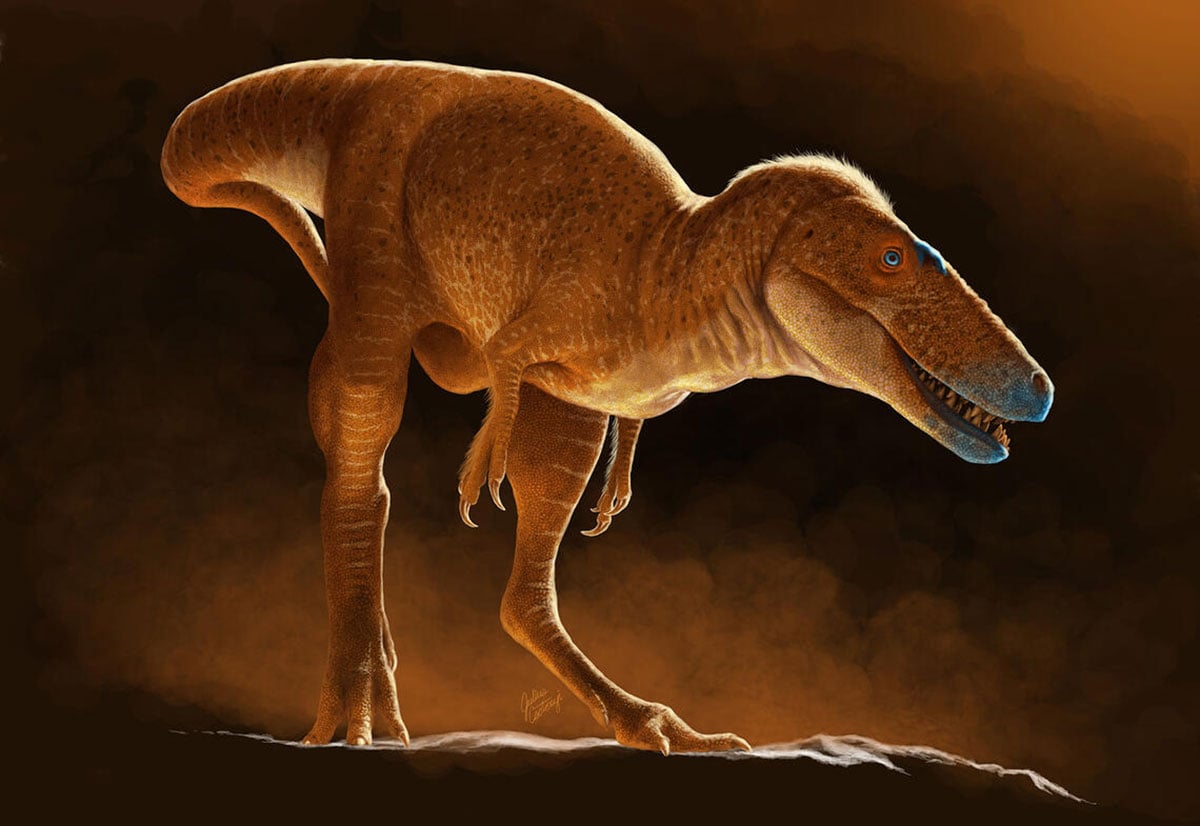
Meet the 'Dragon Prince': Paleontologists Discover T. Rex's Closest Known Ancestor - Khankhuuluu served as a precursor to the famed bone-crushing kings of the Cretaceous. SciTech Daily - October 18, 2025

Argentinian scientists have found fossilized bones of one of the world's oldest dinosaur species in the Andes Mountains
Near-Complete Fossil in Argentina Is One of The World's Oldest Dinosaurs Science Alert - October 18, 2025

Khankhuuluu served as a precursor to the famed bone-crushing kings of the Cretaceous. Paleontologists have uncovered a previously unknown dinosaur species named Khankhuuluu, identified as the closest-known ancestor of the enormous Tyrannosaurs.
Argentina: New 'Megaraptor' Species Found With Shocking Last Meal Still in Its Mouth - A Crocodile Science Alert - September 24, 2025
With no tyrannosaurs around in that part of the world, Joaquinraptor would likely have enjoyed life at the top of the food chain. This fossil find includes some of the most direct evidence of a megaraptor diet so far, which seemed to include the ancient ancestors of crocodiles.
North America's oldest known pterosaur unearthed in Petrified Forest National Park in Arizona PhysOrg - July 7, 2025

A Smithsonian-led team of researchers have discovered North America's oldest known pterosaur, the winged reptiles that lived alongside dinosaurs and were the first vertebrates to evolve powered flight.
Enigmatic 'runner' dinosaur from Colorado helps rewrite understanding of several Jurassic species Live Science - June 26, 2025

A mysterious "runner" dinosaur, only about the size of a dog, scurried around the ancient floodplains of what is now Colorado around 150 million years ago, a new study finds.
New dog-sized dinosaur species discovered CNN - June 26, 2025

Scientists have discovered a new species of dinosaur - one that was dog-sized and roamed what is now the United States around 150 million years ago alongside familiar dinosaurs like stegosaurus and diplodocus.
Long before Tyrannosaurus rex stalked the planet, a Dragon Prince reigned supreme. Paleontologists have discovered a new 'missing link' species that cleared the way for the iconic giant carnivores Science Alert - June 12, 2025

The new mid-size tyrannosaur, which lived about 86 million years ago, has been named Khankhuuluu mongoliensis – a name that translates to "Dragon Prince of Mongolia" in honor of where it was found.
A secret mathematical rule has shaped the beaks of birds and other dinosaurs for 200 million years PhysOrg - April 21, 2025
Bird beaks come in almost every shape and size - from the straw-like beak of a hummingbird to the slicing, knife-like beak of an eagle. We have found, however, that this incredible diversity is underpinned by a hidden mathematical rule that governs the growth and shape of beaks in nearly all living birds. What's more, this rule even describes beak shape in the long-gone ancestors of birds - the dinosaurs.
From dinosaurs to birds: The origins of feather formation PhysOrg - March 20, 2025

Feathers are among the most complex cutaneous appendages in the animal kingdom. While their evolutionary origin has been widely debated, paleontological discoveries and developmental biology studies suggest that feathers evolved from simple structures known as proto-feathers.
Weird bumps in UK quarry turn out to be 166 million-year-old dinosaur 'highway' for some of Jurassic's biggest dinosaurs Live Science - January 3, 2025

Researchers and quarry workers have uncovered a massive dinosaur "highway," which includes hundreds of footprints left by some of U.K.'s biggest dinosaurs. The tracks were uncovered at Dewars Farm Quarry in Oxfordshire and date back to the middle of the Jurassic Period (201.3 million to 145 million years ago). It is the largest dinosaur footprint site in the U.K.
Dinosaur-Era Bird Fills A 70-Million-Year Gap In The Evolution Of Bird Intelligence IFL Science - November 14, 2024

An almost perfect intermediate between Archaeopteryx and modern birds has been discovered with its skull preserved in extraordinary three-dimension. To find such an intact fossil bird that dates back to the Mesozoic is almost unheard of, making the find one of the most significant of its kind, but that's not all.
A giant crocodilian killed the largest 'terror bird' ever found, 12 million years ago Live Science - November 7, 2024

Near-Identical Dinosaur Tracks On Separate Continents Reveal Seismic Split 140 Million Years Ago IFL Science - August 26, 2024
Tracks of near-identical dinosaur prints have been found across two continents, demonstrating how the dinosaurs that made them 120 million years ago were among the last to be able to complete their journey. That’s because this was when the supercontinent Gondwana broke off from Pangea, severing the geological connection. The prints were discovered in Brazil and Cameroon, amounting to over 260 prints in total. When they were laid down in the mud and silt of ancient rivers and lakes, they left behind ichnological evidence of the very different lay of the land that existed during the Early Cretaceous.
Scientists Can Finally Reveal The Secret of How Pterosaurs Took Flight Science Alert - July 15, 2024

The secret to pterosaurs taking flight long before birds and bats dominated the air was wasn't feathers or hollow bones. Although those features no doubt helped, new research shows that a lattice-like structure stopped pterosaurs' broad-ended tails fluttering like flags in the wind and instead, once stiffened, helped guide these flying reptiles into the sky.
'Hidden Gem' Fossil Of Dinosaur Skin Preserved Like Glass Reveals It Had Scales And Feathers IFL Science - May 21, 2024
A new fossil of the partially feathered dinosaur Psittacosaurus has revealed that these animals had bizarre skin that included both bird-like feathers and reptile-like scales. The first-of-its-kind fossil provides new insights into the evolution from scales to feathers, demonstrating that these animals exhibited 'zoned development' in their skin. The first Psittacosaurus fossil was discovered in 1922, but a more recent discovery was able to reveal - for the first time - quite how peculiar their skin was. Dating back to the early Cretaceous, between 135 and 120 million years ago, it lived at a time when dinosaurs were starting to evolve into birds.
Study reveals when the first warm-blooded dinosaurs roamed Earth - Dinosaurs lived year-round in the Arctic fossils reveal CNN - May 16, 2024
A new study suggested that three main dinosaur groups adapted differently to changes in temperature, with the ability to regulate body temperature evolving in the early Jurassic Period about 180 million years ago. Based on fossils from 1,000 dinosaur species and paleoclimate information, the new study looked at the spread of dinosaurs across different environments on Earth throughout the dinosaur era, which started some 235 million years ago and ended 66 million years ago when an asteroid slammed into Earth.
Like 'walking through the woods of millions of years ago': Ancient ecosystem brimming with dinosaur tracks discovered in Alaska Live Science - March 22, 2024
Researchers have discovered a cache of 100 million-year-old dinosaur tracks and other fossils embedded in the foothills of an Alaskan mountain range.
The Coolest Dinosaurs You Should Know About But Probably Don't. IFL Science - December 21, 2023
Did you know some dinosaurs had mohawks? You may well have done, but this guy appears to have his on backwards and paleontologists really don't know why.
75 million-year-old 'forgotten lord of the oasis' titanosaur fossils from Egypt fill a 'black hole' in dinosaur history Live Science - October 12, 2023
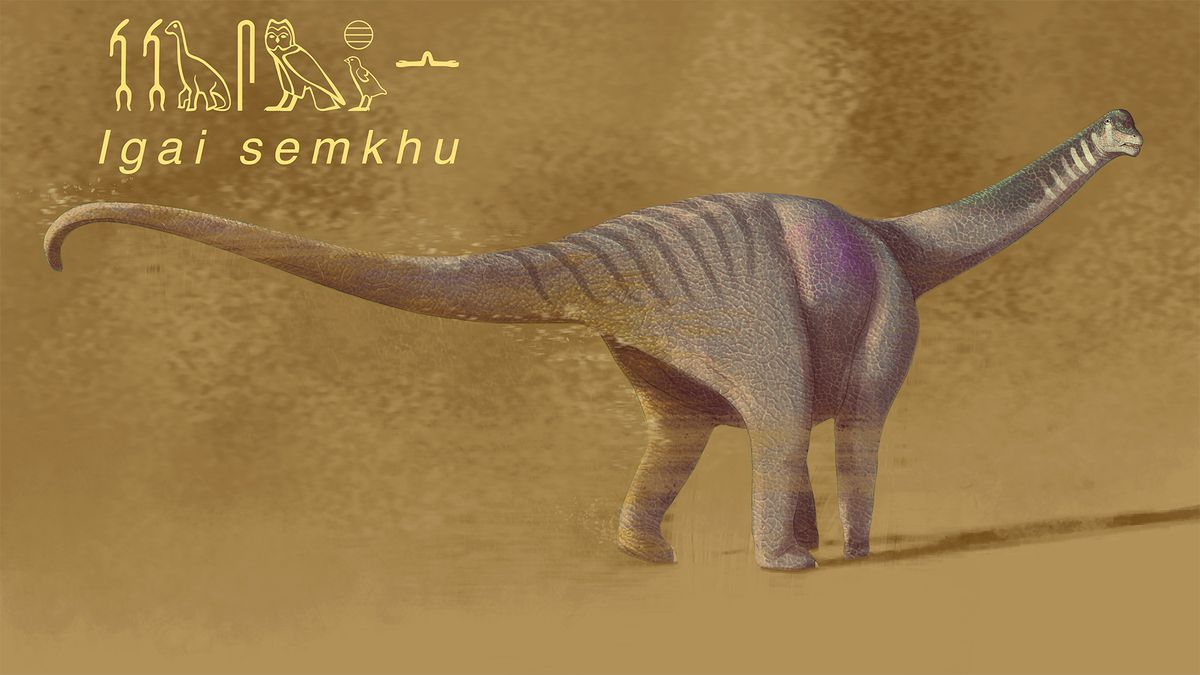
A strange species of tiny titanosaur has finally been given a name, nearly 50 years after its bones were unearthed from th The name Igai semkhu translates to "Forgotten Lord of the Oasis" in ancient Egyptian and can be represented in hieroglyphics. It's named after a deity the Ancient Egyptians would have worshiped in the oasis it came frome Egyptian desert. The newly described species, called Igai semkhu, lived 75 million years ago in what is now the Kharga Oasis.
The ancestors of modern day magnolia flowers survived the mass extinction that killed non-avian dinosaurs IFL Science - September 13, 2023

150 Million-Year-Old Dinosaur Had Uniquely Long Legs Never Seen Before IFL Science - September 7, 2023
Paleontologists May Have Found A Missing Branch Between Dinosaurs And Birds Science Alert - September 7, 2023
69-Million-Year-Old T. Rex Cousins Found Among Africa's Last Dinosaurs IFL Science - August 29, 2023
Two new dinosaur species have been described by scientists in Morocco, dating back to the period just before an asteroid wiped out 90 percent of life on Earth 66 million years ago. They were primitive cousins of the famous Tyrannosaurus rex, only with bulldog snouts and even tinier arms.
Alaska: 70-Million-Year-Old "Dinosaur Coliseum" Is A Vertical Lasagne Of Footprints IFL Science - August 15, 2023
According to the footprint lasagne, the site was popular with large plant-eating duck-billed and horned dinosaurs, as well as some of the rarer carnivores like raptors, tyrannosaurs, and a few small wading birds. It was forested and teeming with dinosaurs. There was a tyrannosaur running around Denali that was many times the size of the biggest brown bear there today. There were raptors, flying reptiles, and birds. It was an amazing ecosystem.
Funky Fossilized Hand Of A New Species Of Theropod Dinosaur Is Like No Other IFL Science - June 23, 2023
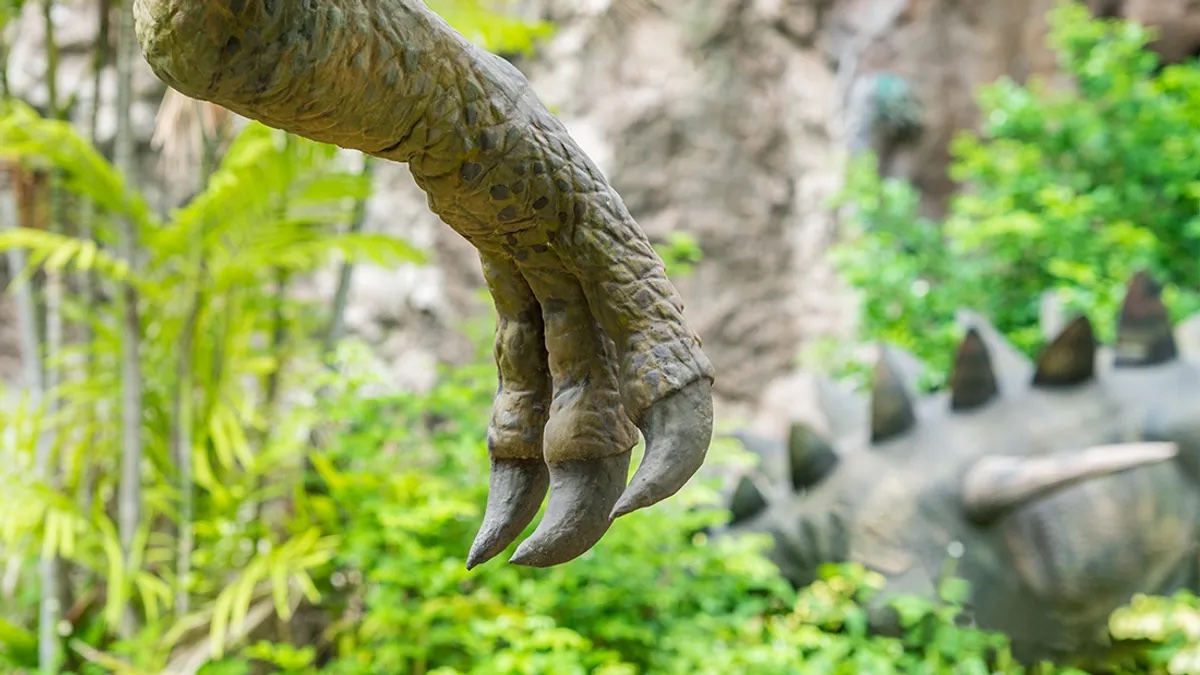
The fossil is thought to be around 121 million years old, from the time of the Early Cretaceous. Owing to the unusual structures present within the hand the team think this is a brand new species, and have named it Migmanychion laiyang. Currently, they suggest that the fossil is part of the coelurosaurian clade Maniraptora, which eventually evolved into the ancestors of modern birds.
Some Dinosaurs Could See Others' Point Of View Long Before Mammals Could IFL Science - May 23, 2023
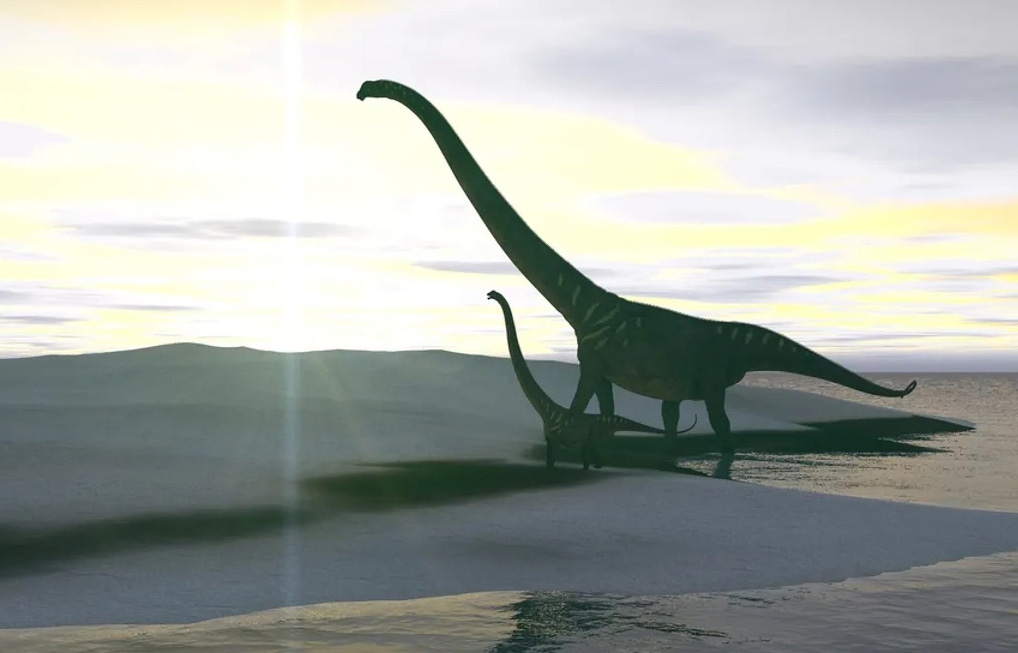
Dinosaurs have been defamed. Far from the ruthless, small-brained creatures often portrayed, a new study proposes they achieved a major advance in intellectual development 60 million years before our mammalian ancestors. Known as 'visual perspective taking' it's the capacity to recognize that not everyone sees the world the same way you do.
Humongous, 100-foot-long dinosaur from Argentina is so big its fossils broke the road during transport Live Science - May 23, 2023
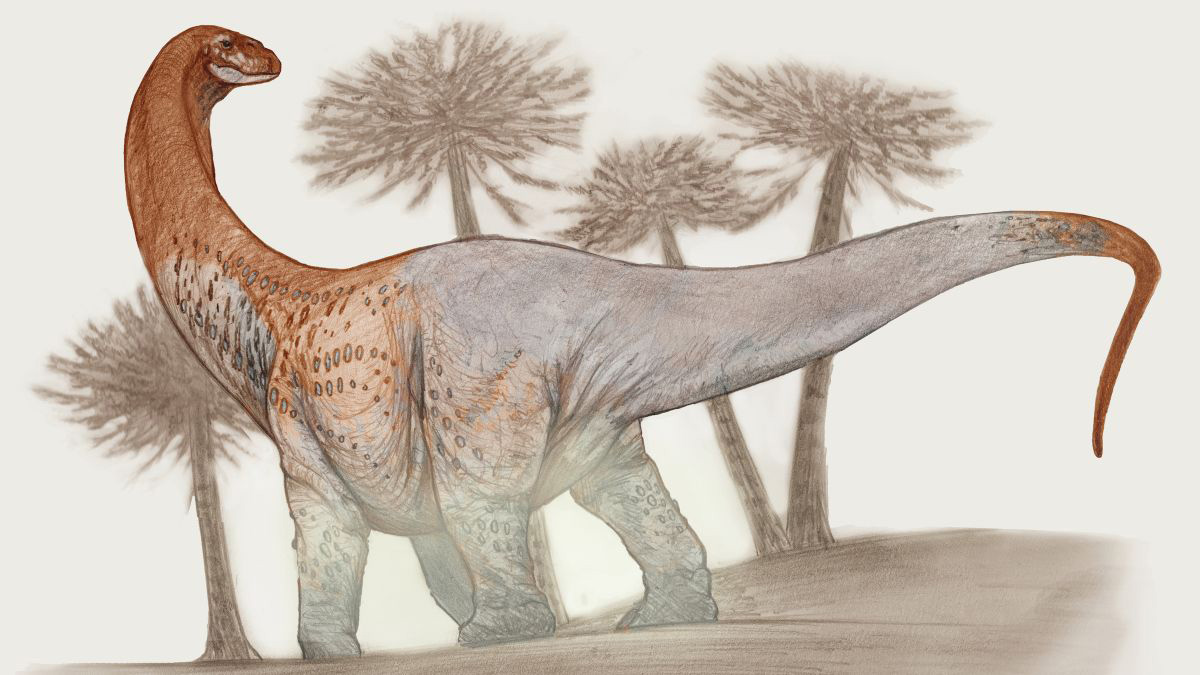
95 million-year-old land bridge across Antarctica carried dinosaurs between continents Live Science - April 17, 2023
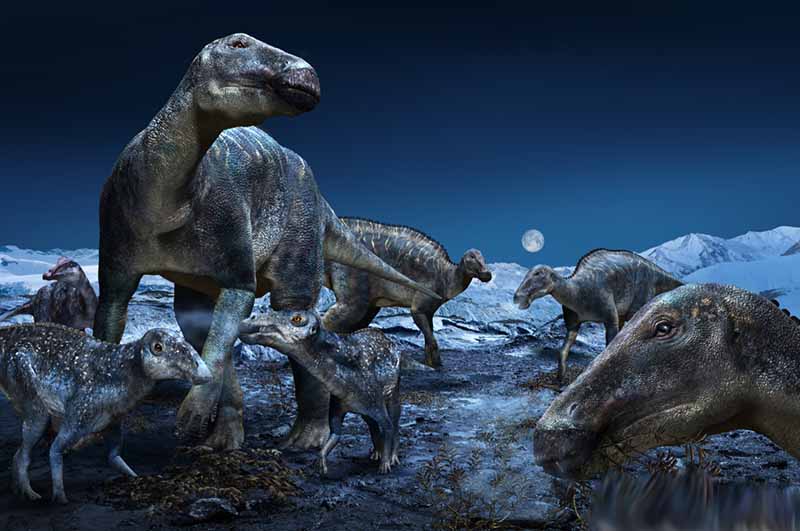
The first-ever near-complete sauropod skull found in Australia is remarkably similar to fossils from South America, which suggests that dinosaurs roamed across ice-free Antarctica. A nearly 100 million-year-old, exceptionally well-preserved sauropod skull discovered in Australia may show that dinosaurs trudged across Antarctica from South America to Australia, researchers have revealed.
Patagotitan, One Of Earth's Largest Dinosaurs, Has Landed In Europe For The First Time Live Science - March 29, 2023
One of the largest dinosaurs ever to walk the Earth was discovered by chance. In 2010, a worker at La Flecha Ranch in Patagonia, Argentina, spotted an enormous dinosaur bone poking out of the ground. Flash forward 13 years, and that pivotal dig site has given rise to the star of Titanosaur: Life As The Biggest Dinosaur, a new exhibition at the Natural History Museum London that features the most complete giant dinosaur ever found:
Incredible Dinosaur Had The Longest Neck Known to Science Science Alert - March 21, 2023
A plant-eating dinosaur that once grazed the greenery in what is today northwest China could hold the title of the longest neck ever known, according to a new analysis of its fossilized bones.
How Did Birds Get Wings? We May Have Found The 'Missing Link' in Dinosaur Fossils Science Alert - February 28, 2023
Dinosaur fossils featuring arms with a suspect bend at the elbow and wrist could hint at the presence of an unpreserved tendon that underpins all modern avian flight. The evolution of wings powerful enough to lift a vertebrate off the ground is one of the greatest mysteries in paleontology. Pterosaurs are famous for being the earliest known vertebrates to achieve true lift-off nearly 200 million years ago. Yet these massive ancient reptile weren't dinosaurs, leaving the direct ancestors of birds to figure out the whole flying business all on their own. Avian dinosaurs would only evolve much later from two-footed, feathered theropods - 80 million years or more after pterosaurs had already achieved powered flight.
Newly Discovered Fossil Reveals Hundreds of Teeth 'Never Seen Before in a Pterosaur' Science Alert - January 30, 2023
A bizarre spatula-billed pterosaur with ridiculous amounts of teeth has been discovered in a German quarry. Its unique facial anatomy suggests it shares feeding traits seen in today's ducks and whales.
Four dinosaur species found in Chilean valley for first time: study PhysOrg - January 12, 2023
Scientists have found the remains of four species of dinosaurs, including a megaraptor, in an inhospitable valley in Chilean Patagonia that has emerged over the past decade as an important fossil deposit.
Fossils reveal prehistoric Patagonian dinosaurs PhysOrg - January 12, 2023
A study led by The University of Texas at Austin is providing a glimpse into dinosaur and bird diversity in Patagonia during the Late Cretaceous, just before the non-avian dinosaurs went extinct. The fossils represent the first record of theropods - a dinosaur group that includes both modern birds and their closest non-avian dinosaur relatives - from the Chilean portion of Patagonia. The researchers' finds include giant megaraptors with large sickle-like claws and birds from the group that also includes today's modern species.
Girl, nine, finds megalodon shark tooth on Maryland beach BBC - January 12, 2023
The megalodon - ancient Greek for "big tooth" - lived in seas worldwide until it died out at least 3.5 million years ago. Growing to more than 66ft (20m) long, the species was not only the biggest shark in the world, but one of the largest fish ever to exist.
This Ancient Creature Is a Bizarre Hybrid of Dinosaur And Bird Science Alert - January 5, 2023
We can confidently say that birds are dinosaur descendants, though paleontologists are still puzzled as to how this incredible evolutionary event occurred. Now a complete fossilized skeleton of a bird that lived in what is today China around 120 million years ago might help clarify key steps in the transformation process, presenting with a more archaic, dinosaur-like head atop a body that has more in common with modern birds.
Rare Dinosaur Fossil Found With Perfectly Preserved Final Meal Inside Science Alert - December 23, 2022
Around 120 million years ago, four-winged dinosaurs roughly the size of crows called Microraptors stalked the ancient woodlands of what is now China. While researchers have studied several Microraptor specimens, there's still a lot we don't know about these feathered bird-like creatures – including what and how they ate.
New fossil foot analysis reveals the surprising and varied lifestyles of dinosaur bird ancestors PhysOrg - December 21, 2022
Newly Discovered Dinosaur Looks Like a Nightmare Goose Gizmodo - December 2, 2022
Paleontologists discovered a 71-million-year-old carnivorous dinosaur in Southern Mongolia that they believe had a body built for swimming and diving for prey. Though it looks a lot like a modern bird, it's actually a non-avian dinosaur, meaning it's likely an example of convergent evolution, a phenomenon in which unrelated creatures evolve similar traits.
None of the bones the researchers uncovered was longer than 12 centimeters (about 5 inches), but they revealed a remarkable amount of detail about the little plant-eating dino that would have walked on two legs and had a powerful, thick tail. It was possible to discern the contours of the brain of Transylvanosaurus, the research team said.
Archaeologists May Have Found The Remains of Europe's Largest Ever Land Predator Science Alert - June 10, 2022
Scientists have found evidence of what might have once been the largest terrestrial hunter in Europe, thanks to a fossil discovery on an island off the south coast of England. Paleontologists suspect the remains of a huge two-legged carnivore, recently unearthed on the Isle of Wight, might be the largest theropod discovered on the continent to date.
Video: Tanis North Dakota Fossil Site: Fossil of dinosaur killed in asteroid strike found, scientists claim BBC - April 7, 2022
The limb, complete with skin, is just one of a series of remarkable finds emerging from the Tanis fossil site in the US State of North Dakota. But it's not just their exquisite condition that's turning heads - it's what these ancient specimens purport to represent.
The claim is the Tanis creatures were killed and entombed on the actual day a giant asteroid struck Earth. The day 66 million years ago when the reign of the dinosaurs ended and the rise of mammals began. Very few dinosaur remains have been found in the rocks that record even the final few thousand years before the impact. To have a specimen from the cataclysm itself would be extraordinary.
'Death Came in Spring': New Evidence Shows When The Dinosaur-Killing Asteroid Struck Science Alert - February 24, 2022
The Chicxulub asteroid that ended the reign of the dinosaurs is one of the most momentous impact disasters in Earth's history, and scientists have now identified the time of year when this deadly event took place.
Scientists Unearth The Ancient Bones of The Largest Jurassic Pterosaur Ever Found Science Alert - February 23, 2022
During low tide on Scotland's Isle of Skye, a graduate student hunting for dinosaur bones looked down at the coastal rocks and made the discovery of a lifetime: the remains of the largest pterosaur on record from the Jurassic period.
Newly Discovered Dinosaur From Argentina Belongs to a Rather 'Armless' Family Science Alert - February 23, 2022
Paleontologists in Argentina have identified a new species of dinosaur which likely had such feeble forearms, it would make Tyrannosaurus rex look like Popeye in comparison. The dinosaur, named Guemesia ochoai and identified from a single skull, is thought to belong to a clade of tiny-armed carnivores known as abelisaurids, which once tramped across Europe, Africa, South America, and India before they went extinct about 66 million years ago.
10 coolest non-dinosaur fossils unearthed in 2021 Live Science - December 28, 2021
Hidden among the Stegosaurus bones and Tyrannosaurus teeth, paleontologists also find a bunch of super cool fossils from other animals that don't always get the attention they might deserve. Here is our list of the top 10 non-dinosaur fossil stories in 2021
Impeccably preserved dinosaur embryo looks as if it 'died yesterday' Live Science - December 21, 2021
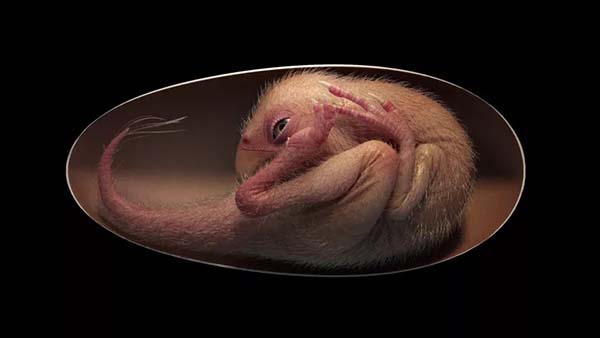
About 70 million years ago, a wee ostrich-like dinosaur wriggled inside its egg, putting itself into the best position to hatch. But that moment never came; the embryo, dubbed "Baby Yingliang," died and remained in its egg for tens of millions of years, until researchers found its fossilized remains in China. Researchers have discovered many ancient dinosaur eggs and nests over the past century, but Baby Yingliang is one of a kind. "This skeleton is not only complete from the tip of the snout to the end of its tail; it is curled in a life pose within its egg as if the animal died just yesterday," said study co-researcher Darla Zelenitsky, an assistant professor of paleontology at the University of Calgary in Alberta, Canada.
Breathtaking Fossil of Baby Dinosaur Tucked in Its Egg Yields New Evolutionary Clues Science Alert - December 21, 2021
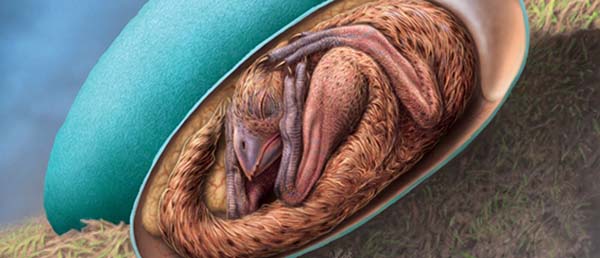
A rare and exquisitely preserved dinosaur embryo tucked inside an egg like a baby bird has been unearthed in southern China, providing an "unprecedented glimpse" into dinosaur development.
Supersaurus might be the longest dinosaur that ever lived Live Science - November 15, 2021
The gold medal for the longest dinosaur in the world might go to the aptly named Supersaurus, now that scientists have fixed a fossil mix-up and analyzed new bones excavated from the long-necked dinosaur's final resting spot. Like other exceedingly long dinosaurs, Supersaurus is a diplodocid - a long-necked sauropod whose whip-like tail went on for days. Supersaurus has always been viewed as one of longest dinosaurs, but research now shows that "this is the longest dinosaur based on a decent skeleton," as other dinosaur remains are fragmentary, and it's challenging to accurately estimate their lengths
Meet 'Cold Bone': The First Distinct Dinosaur Species Ever Found in Greenland Science Alert - November 10, 2021
A pair of 214 million-year-old skulls are thought to belong to the first distinct dinosaur species identified in what is now Greenland, researchers say. Given the name Issi saaneq (or "cold bone" in Greenlandic Inuit), the dino is believed to have been a long-necked, plant-eating sauropodomorph. It's been reconstructed from two skulls discovered back in 1994, which were originally thought to belong to Plateosaurus.
This Tiny, 120-Million-Year-Old Fossil Has a T. Rex-Like Skull on a Bird Body Science Alert - June 27, 2021
A tiny, 120 million-year-old fossil, discovered in northeast China, is neither bird nor dinosaur but is perched on its own evolutionary branch, somewhere in between. While the 2-centimeter-long (0.75-inch) skull of this little fella holds similarities to much larger dinosaurs like Tyrannosaurus rex, its thin and delicate body looks more like modern-day crown birds, such as sparrows or hummingbirds.
Terrifying Tyrannosaurus Rex Lookalike Unearthed in Patagonia Mysterious Universe - April 3, 2021
A newly discovered dinosaur that looked similar to a Tyrannosaurus rex terrorized Patagonia about 80 million years ago. The fossil was discovered in Argentina's Bajo de la Carpa Formation and the dinosaur's braincase was exceptionally well preserved as it was surprisingly uncrushed.
Researchers reconstruct the first complete brain of one of the oldest dinosaurs PhysOrg - November 4, 2020
The study of the brain of extinct organisms sheds lights on their behaviors. However, soft tissues, like the brain, are not usually preserved for long periods. Hence, researchers reconstruct the brains of dinosaurs by analyzing the cranial cavities under computed tomography. It demands well-preserved braincases, which is the region that envelops the brain tissues. To date, complete and well-preserved neurocrania from the oldest dinosaurs worldwide have not been found.
First complete dinosaur skeleton ever found is ready for its closeup at last PhysOrg - August 27, 2020
The first complete dinosaur skeleton ever identified has finally been studied in detail and found its place in the dinosaur family tree, completing a project that began more than a century and a half ago. The skeleton of this dinosaur, called Scelidosaurus, was collected more than 160 years ago on west Dorset's Jurassic Coast. The rocks in which it was fossilized are around 193 million years old, close to the dawn of the Age of Dinosaurs. This remarkable specimen - the first complete dinosaur skeleton ever recovered - was sent to Richard Owen at the British Museum, the man who invented the word dinosaur.
Incredibly Rare Dinosaur Embryo Reveals Hatchlings Possessed Strange Facial Horn Science Alert - August 27, 2020
An 80-million-year-old embryo has revealed some unexpected features of the most titanic animals to ever have walked the Earth. Sauropods, such as Brontosauruses, which lumbered their way through the Jurassic and Cretaceous ages, are well known for their impressive size and long necks. But very little is known about their young.
Using math to examine the sex differences in dinosaurs PhysOrg - August 27, 2020
Unless you find a dinosaur skeleton that contains the fossilized eggs that it was about to lay, or a similar dead giveaway, it's hard to be sure about an individual dinosaur's sex. But many birds, the only living dinosaurs, vary a lot between males and females on average, a phenomenon called sexual dimorphism. Dinosaurs' cousins, the crocodilians, show sexual dimorphism too. So it stands to reason that in many species of dinosaurs, males and females would differ from each other in a variety of traits.
When dinosaurs roamed Moab, Utah Science Moab - August 27, 2020
Most of the really famous dinosaurs were found in the Morrison Formation starting back in the 1870s, like Brontosaurus, Stegosaurus, Allosaurus and Brachiosaurus, which was actually first found in what is now Grand Junction. So it's a pretty well-known formation for dinosaurs. At that time, none of the mountains were here. What is now the Rocky Mountain region was essentially flat. So the whole region that we see now, the Colorado Plateau, all the canyons, the mountains of the Rockies, all that was basically just a big flat floodplain. So it was a very different world.
In death of dinosaurs, it was all about the asteroid - not volcanoes PhysOrg - January 16, 2020
Volcanic activity did not play a direct role in the mass extinction event that killed the dinosaurs. Most scientists acknowledge that the mass extinction event, also known as K-Pg, occurred after an asteroid slammed into Earth. Some researchers also have focused on the role of volcanoes in K-Pg due to indications that volcanic activity happened around the same time.
Fossils of largest theropod to date found in Australia PhysOrg - January 16, 2020
A team of researchers from the University of New England, the Australian Age of Dinosaurs Natural History Museum and Swinburne University of Technology, all in Australia, has identified fossils found near Winton as remains of the largest theropod found to date in Australia. The fossils closely resembled Australovenator wintonesis - a theropod species that was discovered in Australia in 2006. Theropods are a group of large, bipedal, carnivorous dinosaurs—included in the group are both Tyrannosaurus rex and Velociraptor.
Rocks at asteroid impact site record first day of dinosaur extinction PhysOrg - September 9, 2019
When the asteroid that wiped out the dinosaurs slammed into the planet, the impact set wildfires, triggered tsunamis and blasted so much sulfur into the atmosphere that it blocked the sun, which caused the global cooling that ultimately doomed the dinos.
Dinosaur brains from baby to adult PhysOrg - August 15, 2019
New research by a University of Bristol palaeontology post-graduate student has revealed fresh insights into how the braincase of the dinosaur Psittacosaurus developed and how this tells us about its posture. Psittacosaurus was a very common dinosaur in the Early Cretaceous period - 125 million years ago - that lived in eastern Asia, especially north-east China. Hundreds of samples have been collected which show it was a beaked plant-eater, an early representative of the Ceratopsia, which had later relatives with great neck frills and face horns, such as Triceratops.
Scientists have revealed that fossils from an underground opal mine near Lightning Ridge, outback NSW, include remains from of 4 dinosaurs, among them a new dinosaur species and the world's most complete opalized dinosaur PhysOrg - June 6, 2019
The new dinosaur has been named Fostoria dhimbangunmal in honor of opal miner Robert Foster, who discovered the fossils in the 1980s. The species name, dhimbangunmal (pronounced bim-baan goon-mal), means "sheep yard" in the local Yuwaalaraay and Yuwaalayaay languages, in recognition of the Sheepyard locality where the bones were found.
Perfectly preserved dinosaur skin found in Korea PhysOrg - April 9, 2019
Paleontologists are used to finding dinosaur bones and tracks. But remnants of soft tissue, like muscles or skin, are rare and often not well preserved. A very small percentage of tracks - much less than 1% - show skin traces. The skin traces come from tracks of the smallest known theropod, the Minisauripus. The footprints are only an inch long, and the scientists were able to find perfectly preserved skin traces on them. This was the 10th discovery of a site with Minisauripus tracks and the first to show skin traces.
Do volcanoes or an asteroid deserve blame for dinosaur extinction? Science Daily - February 21, 2019
Scientists have obtained more precise dates for the Deccan Traps volcanic lava flows, linking peak activity more closely to the asteroid or comet impact 66 million years ago and the coincident mass extinction. But if greenhouse gases emitted before the impact created a hothouse climate that set life up for a fall when the impact cooled the planet, those gases did not coincide with the largest lava flows from the Deccan Traps.
New species of tiny tyrannosaur foreshadows rise of T. rex PhysOrg - February 21, 2019
newly discovered, diminutive - by T. rex standards - relative of the tyrant king of dinosaurs reveals crucial new information about when and how T. rex came to rule the North American roost.
The oldest large-sized predatory dinosaur comes from the Italian Alps PhysOrg - December 19, 2018
Early Jurassic predatory dinosaurs are very rare, and mostly small in size. Saltriovenator zanellai, a new genus and species is the oldest known ceratosaurian, and the world's largest (one ton) predatory dinosaur from the Lower Jurassic. This unique specimen, which also represents the first Jurassic dinosaur from Italy, was accidentally discovered in 1996 by a fossil amateur within a quarry near Saltrio, some 80 km N-E of Milan. Many bones of Saltriovenator bear feeding marks by marine invertebrates, which represent the first case on dinosaurian remains and indicate that the dinosaur carcass floated in a marine basin and then sunk, remaining on the sea bottom for quite a long time before burial.
Fossilized tooth reveals prehistoric aerial battle as an eight foot shark leapt out of the sea to bring down a far larger pterosaur Daily Mail - December 19, 2018
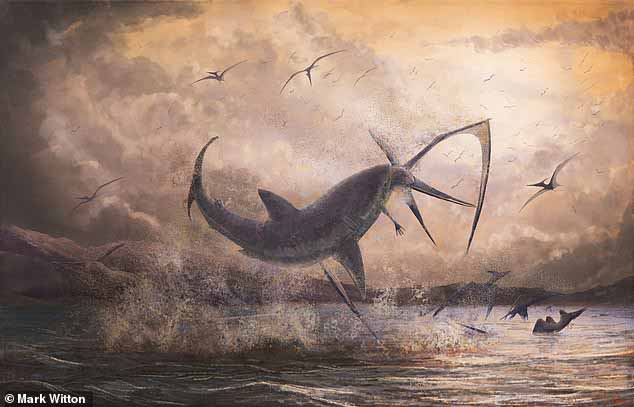
Researchers have revealed astonishing evidence of a ferocious mid air battle between a shark and a pterosaur. USC researchers studying bones at the L.A. County Natural History Museum, were shocked to find a fossil from the fearsome flying reptile that had a shark tooth lodged in it. They believe the find is the result of a fearsome shark six feet long leaping into the air to try and take down the much larger pterosaur with a wingspan of 18 feet.
Evidence of a fearsome shark taking down a pterosaur in mid-flight PhysOrg - December 19, 2018
It was a prehistoric clash of the ages that didn't end pretty when a monster in the sky clashed with a beast of the deep. The sorry outcome for one particular flying reptile is brutally recorded on a fossil where a shark chomped its neck, leaving a telltale tooth wedged against a vertebra. USC researchers who studied the bones kept at the Los Angeles County Natural History Museum say it's a rare glimpse of wildlife interactions in the age of dinosaurs.
'Superlungs' gave dinosaurs the energy to run and fight'Superlungs' gave dinosaurs the energy to run and fight PhysOrg - October 24, 2018
In the oxygen-poor air of the Mesozoic era, nothing should have been able to move very fast. But Velociraptors could run 64 kilometers per hour. Their secret weapon: super-efficient, birdlike lungs, which would have pumped in a constant supply of oxygen, according to a new study. This unique adaptation may have given all dinos a leg up on their competition.
T-Rex didn't have feathers! 'World's most accurate reconstruction' of the ferocious dinosaur shows it was chubby, had smooth skin and walked with its belly close to the ground Daily Mail - October 15, 2018
The world's most accurate depiction of a Tyrannosaurus Rex ever made has been created, according to researchers. Artists and paleontologists joined forces to build a painstaking computer-generated image of the prehistoric beast, from skeleton to skin. The results are considerably different to all previous renderings, some of which show the king of the dinosaurs with feathers. Experts now say the fearsome T Rex was actually smooth-skinned.
Rare intermediate fossils give researchers insight into evolution of bird-like dinosaur Science Daily - August 23, 2018
An international team of researchers discovered a new species of dinosaur, Xiyunykus pengi, during an expedition to Xinjiang, China. The discovery is the latest stemming from a partnership between the George Washington University and the Chinese Academy of Sciences. The findings along with the description of a second new intermediate species, Bannykus wulatensis. Xiyunykus and Bannykus are both alvarezsaurs, an enigmatic group of dinosaurs that share many characteristics with birds. Their bodies are slender, with a bird-like skull and many small teeth instead of the usual large, sharp cutting teeth of their meat-eating relatives.
Fossil of 'first giant' dinosaur discovered in Argentina BBC - July 10, 2018
They are the biggest animals to have walked the Earth, with some weighing as much as a space shuttle. However, it is unclear how dinosaurs grew to such massive proportions. A new dinosaur discovery from Argentina gives fresh evidence on the rise of the giants.
The animal used a novel strategy to become super-sized, involving very fast growth spurts and efficient bird-like lungs, say paleontologists. The fossil was found in the northwest of Argentina during a field trip. The scientists found four skeletons in all, one of a new species and three of related dinosaurs.
Genome structure of dinosaurs discovered by bird-turtle comparisons Science Daily - May 21, 2018
A discovery has provided significant insight into the overall genome structure of dinosaurs. By comparing the genomes of different species, chiefly birds and turtles, the Kent team were able to determine how the overall genome structure (i.e. the chromosomes) of many people's favourite dinosaur species - like Velociraptor or Tyrannosaurus - might have looked through a microscope.
Rare Tiny T. Rex Unearthed in Montana Smithsonian - April 4, 2018
In the last 100 years of excavations, fewer than five juvenile T. rex have come out of Hell Creek, which boasts an impressive assemblage of ancient remains. And the latest find may be the best so far. This is probably the most preserved and most complete. This is a 1-in-100-million specimen.
Dinosaur tracks on Skye 'globally important' BBC - April 3, 2018
New light has been shed on a little understood period of dinosaur evolution after giant prehistoric footprints were discovered on the Isle of Skye. Researchers, including some from Edinburgh University, have been analyzing dozens of the footprints, left about 170 million years ago. They found that the tracks belonged to sauropods and therapods from the Middle Jurassic period. The discovery has been described as being "globally important". Few fossil sites have been found around the world from the Middle Jurassic period. The footprints, left in a muddy, shallow lagoon, are helping the researchers build a more accurate picture of an important period in dinosaur evolution.
Rare Scottish dinosaur prints give key insight into era lost in time PhysOrg - April 2, 2018
Dozens of giant footprints discovered on a Scottish island are helping shed light on an important period in dinosaur evolution. The tracks were made some 170 million years ago, in a muddy, shallow lagoon in what is now the north-east coast of the Isle of Skye.
Most of the prints were made by long-necked sauropods - which stood up to two metres tall - and by similarly sized theropods, which were the older cousins of Tyrannosaurus rex.
The find is globally important as it is rare evidence of the Middle Jurassic period, from which few fossil sites have been found around the world. Researchers measured, photographed and analyzed about 50 footprints in a tidal area at Brothers' Point - Rubha nam Brathairean - a dramatic headland on Skye's Trotternish peninsula. The footprints were difficult to study owing to tidal conditions, the impact of weathering and changes to the landscape. In spite of this, scientists identified two trackways in addition to many isolated foot prints. Researchers used drone photographs to make a map of the site. Additional images were collected using a paired set of cameras and tailored software to help model the prints.
Baby bird fossil is 'rarest of the rare' BBC - March 5, 2018
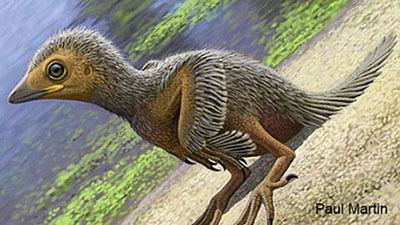
The chick lived 127 million years ago and belonged to a group of primitive birds that shared the planet with the dinosaurs. Fossils of birds from this time period are rare, with baby fossils seen as "the rarest of the rare". Scientists say the discovery gives a peek into the lives of the ancient, long-extinct birds that lived between 250 and 66 million years ago.
New Egyptian dinosaur reveals ancient link between Africa and Europe Science Daily- January 29, 2018
When it comes to the final days of the dinosaurs, Africa is something of a blank page. Fossils found in Africa from the Late Cretaceous, the time period from 100 to 66 million years ago, are few and far between. That means that the course of dinosaur evolution in Africa has largely remained a mystery. But in the Egyptian Sahara Desert, scientists have discovered a new species of dinosaur that helps fill in those gaps.
Fossils of 75 million-year-old dinosaur that looked like a mutant swan with a reptilian tail are found by stunned archaeologists in Mongolia Daily Mail - December 7, 2017

A bizarre feathered dinosaur resembling a nightmarish mutant swan has been identified by scientists. The strange creature had a graceful swan-like neck but also scythe-like claws, a reptilian tail, and a beak lined with teeth. Halszkaraptor escuilliei, which lived 75 million years ago, was about the size of a modern swan and is thought to have been semi-aquatic.
'Bandit-masked' feathered dinosaur hid from predators using multiple types of camouflage PhysOrg - October 26, 2017
By reconstructing the likely color patterning of the Chinese dinosaur Sinosauropteryx, researchers have shown that it had multiple types of camouflage which likely helped it to avoid being eaten in a world full of larger meat-eating dinosaurs, including relatives of the infamous Tyrannosaurus Rex, as well as potentially allowing it to sneak up more easily on its own prey.
Move aside T-Rex! New species of 'mega-carnivore' dinosaur roamed southern Africa 200 million years ago and was 'top of the food chain' Daily Mail - October 26, 2017
A dinosaur as big as a bus roamed southern Africa 200 million years ago, scientists have revealed thanks to the discovery of several huge three-toed footprints. The new species, Kayentapus ambrokholohali, is a relative of Tyrannosaurus rex and was identified by its footprints, which are nearly two feet (23 inches) long. Dinosaurs are recorded as only first appearing on Earth around 230 million years ago, so the new find shocked researchers as it shows they grew big very quickly.
'Ugly' 16ft-long dinosaur is found in the south of France with terrifying 2.5-inch teeth that tore through food like scissors 80 million years ago Daily Mail - October 26, 2017
The plant eater - which grew to more than 16 feet long - had an unusually short face with powerful jaws that enabled it to snack on tough riverside palm trees. Its two-and-a-half inch teeth worked 'like a pair of scissors' as it chewed the hard foliage, before swallowing.
New tyrannosaur fossil is most complete found in Southwestern US Science Daily - October 19, 2017
A fossilized skeleton of a tyrannosaur discovered in Utah's Grand Staircase-Escalante National Monument was airlifted by helicopter Oct 15, and delivered to the Natural History Museum of Utah where it will be uncovered, prepared, and studied. The fossil is approximately 76 million years old and is likely an individual of the species Teratophoneus curriei.
How did dinosaurs evolve beaks and become birds? Scientists think they have the answer PhysOrg - September 28, 2017
Once you know that many dinosaurs had feathers, it seems much more obvious that they probably evolved into birds. But there's still a big question. How did a set of dinosaurian jaws with abundant teeth (think T. rex) turn into the toothless jaws of modern birds, covered by a beak? Two things had to happen in this transition, suppression of the teeth and growth of the beak. Now new fossil evidence has shown how it happened.
Scientists track the brain-skull transition from dinosaurs to birds Science Daily - September 11, 2017
The dramatic, dinosaur-to-bird transition that occurred in reptiles millions of years ago was accompanied by profound changes in the skull roof of those animals -- and holds important clues about the way the skull forms in response to changes in the brain -- according to a new study. It is the first time scientists have tracked the link between the brain's development and the roofing bones of the skull.
How dinosaurs evolved into birds - Scientists reveal how incredible transition 100 million years ago saw profound changes to animals' skulls Daily Mail - September 11, 2017
The transition of dinosaurs to birds began around 100 million years ago, and a new study suggests that the changes during this time went well beyond the growth of feathers. New research indicates that the transition was also accompanied by profound changes to those animals' skulls. The findings hold important clues about the way the skull forms in response to changes in the brain, according to the researchers.
66 Million Years Ago, Bird-Like Dinosaurs Laid Blue-Green Eggs Live Science - August 31, 2017
A type of bird-like dinosaur that lived in what is now China during the Cretaceous period - about 145.5 million to 65.5 million years ago - laid eggs that had a bluish-green tint, the first evidence of pigment in dinosaur eggs, according to a new study. The well-preserved eggshells belonged to the oviraptorid Heyuannia huangi, and analysis revealed the hints of blue-green color, the researchers said. Oviraptorids were a small-bodied, short-snouted group of dinosaurs with toothless beaks, and are known from fossils found in Mongolia and China. Blue and green egg hues are found in eggs belonging to many types of modern birds, and were long thought to have originated in bird lineages. This new finding, however, implies that egg coloration appeared earlier in the dinosaur family tree, and might have emerged alongside nesting behavior that left eggs partially exposed in nest mounds, rather than buried underground.
So Long, Sue! Famed T. Rex Makes Way for Bigger Beast Live Science - August 31, 2017
After spending nearly 18 years in the Field Museum's great hall in Chicago, Sue - the largest and most complete Tyrannosaurus rex ever discovered - will move to an exhibit upstairs, making room for the world's largest known dinosaur: a titanosaur.
Unique imaging of a dinosaur's skull tells evolutionary tale
Researchers using Los Alamos' unique neutron-imaging and high-energy X-ray capabilities have exposed the inner structures of the fossil skull of a 74-million-year-old tyrannosauroid dinosaur nicknamed the Bisti Beast in the highest-resolution scan of tyrannosaur skull ever done. The results add a new piece to the puzzle of how these bone-crushing top predators evolved over millions of years.
Rare tooth find reveals horned dinosaurs in eastern North America PhysOrg - May 24, 2017
A chance discovery in Mississippi provides the first evidence of an animal closely related to Triceratops in eastern North America. The fossil, a tooth from rocks between 68 and 66 million years old, shows that two halves of the continent previously thought to be separated by seaway were probably connected before the end of the Age of Dinosaurs. Horned dinosaurs, or ceratopsids, had previously only been found in western North America and Asia. A seaway down the middle of North America, which linked the Arctic Ocean and Gulf of Mexico, split the continent into eastern and western halves during much of the Late Cretaceous (around 95 to 66 million years ago). This means that animals that evolved in western North America after the split-including ceratopsids were prevented from traveling east.
Tooth that proves 'Triceratops-style' horned dinosaurs roamed eastern US could rewrite our planet's history Daily Mail - May 24, 2017
A chance discovery of a single tooth in Mississippi provides the first evidence of an animal closely related to Triceratops in eastern North America. Until now, most experts believed North America was split by a vast sea. However, this rare 68 to 66 million-year-old tooth suggests there was a bridge between the two sides.
First baby of a gigantic Oviraptor-like dinosaur belongs to a new species PhysOrg - May 9, 2017
A new species of giant bird-like dinosaur - which tended to enormous nests that were bigger than a monster truck tire - has been discovered in Henan, China. The new species, named Beibeilong, lived about 90 million years ago during the Cretaceous Period. It is described by a joint Chinese-Canadian-Slovakia team based on a number of large eggs and an associated embryo that were collected in China
Mars volcano, Earth's dinosaurs went extinct about the same time PhysOrg - March 20, 2017
Around the same time that the dinosaurs became extinct on Earth, a volcano on Mars went dormant, NASA researchers have learned. Arsia Mons is the southernmost volcano in a group of three massive Martian volcanoes known collectively as Tharsis Montes. Until now, the volcano's history has remained a mystery. But thanks to a new computer model, scientists were finally able to figure out when Arsia Mons stopped spewing out lava. According to the model, volcanic activity at Arsia Mons came to a halt about 50 million years ago. Around that same time, Earth experienced the Cretaceous-Paleogene extinction event, which wiped out three-quarters of its animal and plant species, including the dinosaurs.
How dinosaurs learned to stand on their own two feet Science Daily - March 3, 2017
Paleontologists have developed a new theory to explain why the ancient ancestors of dinosaurs stopped moving about on all fours and rose up on just their two hind legs. Bipedalism in dinosaurs was inherited from ancient and much smaller proto-dinosaurs. The tails of proto-dinosaurs had big, leg-powering muscles. Having this muscle mass provided the strength and power required for early dinosaurs to stand on and move with their two back feet. We see a similar effect in many modern lizards that rise up and run bipedally. Over time, proto-dinosaurs evolved to run faster and for longer distances. Adaptations like hind limb elongation allowed ancient dinosaurs to run faster, while smaller forelimbs helped to reduce body weight and improve balance. Eventually, some proto-dinosaurs gave up quadrupedal walking altogether.
Paleontologist suggests path to flight for dinosaurs not as straight as thought PhysOrg - February 25, 2017
When most people think of the evolution of a particular feature or ability, they tend to think of a straight line - a species develops a feature that allows it to do something better; its offspring also express that feature, and soon another feature is added until something like wings for flight develop.
First live birth evidence in dinosaur relative BBC - February 16, 2017
Scientists have uncovered the first evidence of live births in the group of animals that includes dinosaurs, crocodiles and birds. All examples of this group, known as the Archosauromorpha, lay eggs. This led some scientists to wonder whether there was something in their biology that prevented live births. But examination of the fossil remains of a very long-necked, 245 million-year-old marine reptile from China revealed it was carrying an embryo.
Dino-bird fossil had sparkly feathers 'to attract mate ' BBC - November 15, 2016

An extinct bird that lived about 120 million years ago had iridescent feathers that it may have used to attract a mate, fossil evidence shows. The prehistoric bird, which was found recently in China, may have puffed up its feathers like a peacock. The bird's feathers are "remarkably preserved", including the chemical that gave them sparkle. The animal belongs to a group of early birds known as enantiornithines, which lived during the Age of the Dinosaurs. All known specimens come from rocks in Liaoning, China, which have yielded numerous fossils of feathered dinosaurs, primitive birds and pterosaurs.
Biggest map of dinosaur tree yet suggests they emerged 20 million years earlier than thought PhysOrg - November 9, 2016
A team of researchers from the U.K. and the U.S. has mapped the biggest dinosaur tree yet, and in so doing, has found that the creatures may have evolved 20 million years earlier than most in the field have thought.
The Incredible Reptiles That Flew 200 Million Years Ago Smithsonian - November 7, 2016
A 200-million-year-old fossil reveals the amazing body structure of a reptilian creature known as the dimorphodon. Not only did it possess wings, it was one of the first large vertebrates to travel by air. (2:41)
Fossilized dinosaur brain tissue identified for the first time Science Daily - October 28, 2016
Researchers have identified the first known example of fossilized brain tissue in a dinosaur from Sussex. The tissues resemble those seen in modern crocodiles and birds. An unassuming brown pebble, found more than a decade ago by a fossil hunter in Sussex, has been confirmed as the first example of fossilized brain tissue from a dinosaur. The fossil, most likely from a species closely related to Iguanodon, displays distinct similarities to the brains of modern-day crocodiles and birds. Meninges -- the tough tissues surrounding the actual brain -- as well as tiny capillaries and portions of adjacent cortical tissues have been preserved as mineralized 'ghosts'.
Giant dinosaur footprint discovered in Mongolia desert PhysOrg - September 30, 2016
One of the biggest dinosaur footprints ever recorded has been unearthed in the Gobi Desert, researchers said Friday, offering a fresh clue about the giant creatures that roamed the earth millions of years ago. A joint Mongolian-Japanese expedition found the giant print, which measures 106 centimetres (42 inches) long and 77 centimetres wide. One of several footprints discovered in the vast Mongolian desert, the huge fossil was discovered last month in a geologic layer formed between 70 million and 90 million years ago, researchers said.
Ancient birds' wings preserved in amber BBC - June 28, 2016
Two wings from birds that lived alongside the dinosaurs have been found preserved in amber. The "spectacular" finds from Myanmar are from baby birds that got trapped in the sticky sap of a tropical forest 99 million years ago. Exquisite detail has been preserved in the feathers, including traces of color in spots and stripes. The wings had sharp little claws, allowing the juvenile birds to clamber about in the trees. The tiny fossils, which are between two and three centimeters long, could shed further light on the evolution of birds from their dinosaur ancestors.